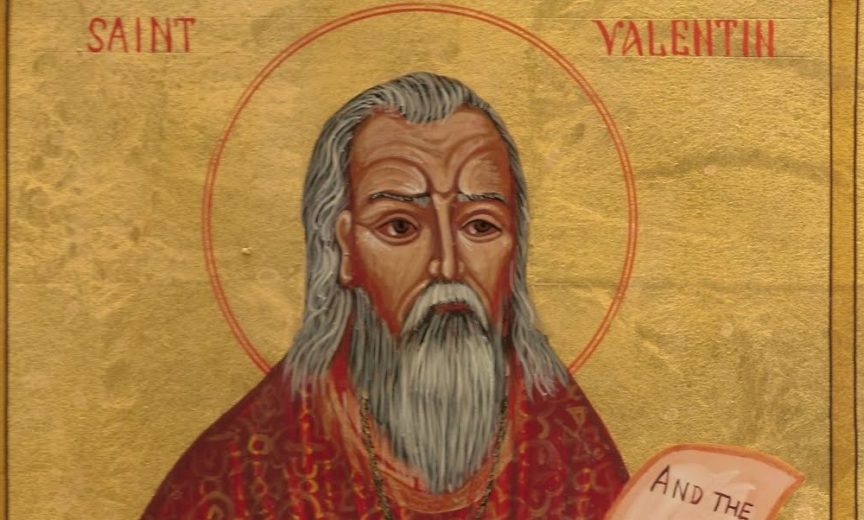There is quite a bit of mystery about the origins of Valentine’s Day. Everything from its namesake to its pagan beginnings can’t be definitively proven and seems loosely drawn together. Lots of speculation and conjecture, a few possible leads but nothing that hands down proves how it started. I find the stories behind this holiday fascinating since it draws together stories of multiple martyrs, fertility rites, and medieval poets.
Let’s start with the mysterious martyr, St. Valentine. First, the name was not Valentine but Valentinus, or Valentino in Italian, but we’ll keep the anglicized name that’s most familiar. There are stories attributed to three different men; St. Valentine of Rome, St. Valentine of Terni, and St. Valentine who died in North Africa. They all apparently died on February 14th. There is hardly any information about North Africa Valentine other than he was killed with a bunch of other people in North Africa, so we’ll just stick to the first two stories.
St Valentine of Rome and St. Valentine of Terni could be two different people or the same person. Valentine of Rome might have been a former bishop of Terni. There are several different years attributed to his date of death which may be why there’s confusion as to how many Valentines there actually were. Some say he died during the reign of Emperor Gallienus and others Emperor Claudius Gothicus (Claudius II). Most research states he died either in 269 or 270 AD, which leaves out Gallienus was assassinated in 268.
Valentine’s execution could have been for performing Christian marriages or performing marriages for soldiers. Claudius II forbid soldiers to get married. He thought single men made better soldiers than married men who didn’t want to leave their wives and families to go to war. Many Catholic and religious sites believe he was simply persecuted for being Christian and trying to convert others.
Some stories have him converting a judge by curing his daughter of blindness. Others have him befriending a jailer’s blind daughter then leaving a note behind that read “From your Valentine.” One story has him leave the note for a woman he either became enamored with or befriended while incarcerated.
Other accounts say he charmed Claudius II, but when instead of renouncing his faith he tried to convince Claudius to convert, Claudius became irate and condemned him to death. In all of these stories, he’s beaten and beheaded then buried on the Via Flaminia on February 14th. Today, several locations claim to have pieces of St Valentine’s remains as relics on display. Most notably, the Basilica of Santa Maria in Cosmedin, Rome displays his flower adorned skull.
In most of the stories I read about Valentine’s Day, Pope Gelasius I declared February 14th the feast of St. Valentine in 496 and listed him amongst the saints “whose names are rightly reverenced among us, but whose actions are known only to God.” He may still be the patron saint of love and happy marriages, but he was taken out of the General Roman Calendar in 1969 because so little was known about him. He is also the patron saint of beekeepers, epilepsy, fainting, plague, travelers, and young people
Pope Gelasius I worked hard to make Rome the seat of Catholicism. He also did his best to pin that pesky pagan festival, Lupercalia, to the mat after centuries of popularity. Some claim that Pope Gelasius used Valentine’s Day to supplant Lupercalia, and many believe he succeeded. Others argue that Lupercalia’s end came not with St. Valentine’s Day but with a letter to Senator Andromachus. There is very little evidence to support these claims other than a rather stern letter to the senator.
Lupercalia was a Roman fertility festival that is so ancient little is known of its origin. The festival was in honor of Rome’s founders, the twins Romulus and Remus, who were saved by a she-wolf when left for dead. After they had returned home to take back their stolen throne, they turned the wolf den of their youth into a sacred site. From then on, two men representing Romulus and Remus would sacrifice a dog and a goat (the defender of the herd and the herding animal) and clothe themselves in goat skins (which makes me think of the goat leggings in the 1980’s version of Dragnet).
After the post-sacrificial ritual, a feast would ensue, then the two men would run around the town slapping or touching people with goat strips/thongs for purification. Women thought it would ensure fertility and ease childbirth, which explains why they would want to get slapped with a possibly bloody strap of goatskin. And we’re talking strips of goat skin, not thick leather, so think of it as light, festive slaps and not getting beaten.
Lupercalia’s history includes stories that single women/young girls put their names in a pot then single men/young boys drew the names out of women who would then be their companions for the night, or a day, or a year depending on who’s telling the story. Companion is translated in many ways but often to sexual partners, but I can’t find any proof that happened. Some make it sound like it was speed dating, and if you hit it off, you got a life partner.
The earliest writing about this activity dates as early as 1756 and is most likely made up. Lupercalia probably had just fallen out of favor as some ancient festivals do. I’m sure the church thinks it hoodwinked the pagans with its new Catholic approved saint festival but that may not have been the case. It just may have run its course.
But Lupercalia was the reason for the season in its time and not the reason why we give notes of affection on the 14th today. That evolved over time from as early as the medieval era when Feb 14th was thought of as the day birds start mating. This made it was the perfect time for thoughts and words of love. The first documented writing about Valentine’s day is a medieval poem by Geoffrey Chaucer. The Parlement of Foules (also known as the Parliament of Birds) was penned in the 14th century and contains a stanza that about Valentine’s Day, “For this was on Saint Valentine’s day when every fowl comes there his mate to take.” There is even mention of Valentine’s Day in Hamlet.
By the 18th century, the passing of elaborate cards on Feb 14th was all the rage. By the 1840’s, Esther Howland created mass-produced cards to sell to the public since many people didn’t have time to make elaborate ribbon and lace laden notes anymore. In 1913, Hallmark started selling mass-produced Valentine’s Day cards ushering in the holiday we know today.
Now we can pass along e-cards to our lovebirds. And while we grumble about commercialization or that it’s just a manufactured holiday (which it is), at least no one in goat leggings is slapping you with strips of bloody goat skin. And if you are, who am I to yuck your yum. Enjoy the holiday in any consensual way you like.


